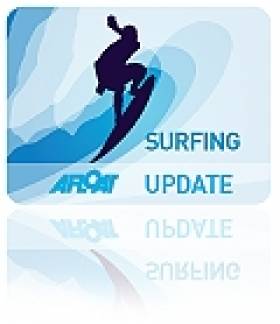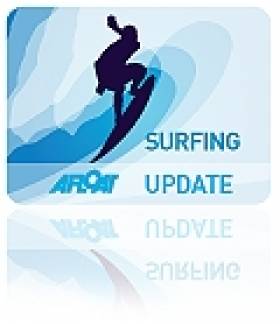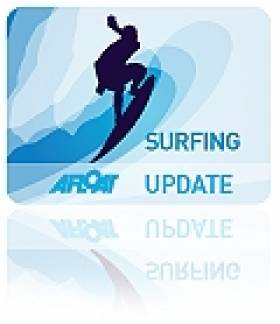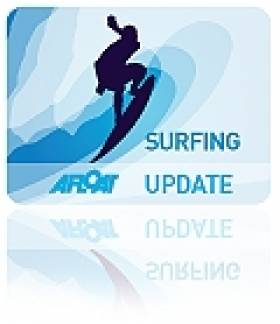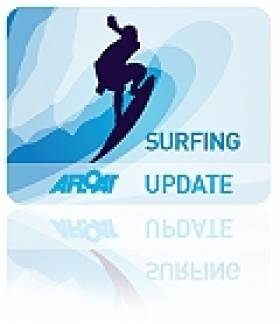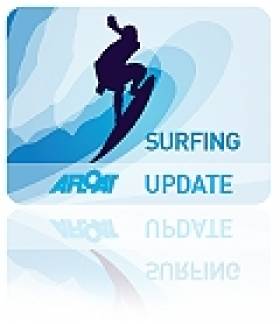Displaying items by tag: Surfing
Irish Surfer Takes Mr Price Pro Title in South Africa
#SURFING - Irish surfer Glenn Hall took the top prize at the ASP Prime Mr Price Pro event in South Africa recently.
As AllAfrica.com reports, surfing pro Hall - who was born in Australia - beat Nathaniel Curran from the USA in the final at Willards Beach in Ballito, on the north coast of KwaZulu-Natal provice on the Indian Ocean, to clinch the title.
"It's the biggest win of my career by far," he said. "I kind of felt like if you got the wave out there you could get the score and I was just praying for a wave at the end."
The victory continues a prosperous year for the former ASP Australasian Pro Junior champion, with wins in China and Trestles in California seeing him rise to 16th in the world rankings.
AllAfrica.com has more on the story HERE.
Blind Surfers Hit the Waves to Raise Funds for Guide Dogs
#SURFING - Blind surfers from throughout Northern Ireland took to the waves recently to raise money for Guide Dogs NI, as UTV News reports.
The surfers converged on Benone beach in Limavady last weekend for their first-ever sponsored surf, using specially adapted boards - and donning wetsuits against the cold of the Atlantic in this wintry summer.
As previously reported on Afloat.ie, the same stretch of sand hosted Northern Ireland's first ever disabled surfing festival last month.
Like that event, this fundraiser was also supported by the Long Line Surf School, which is specialising in courses for people with various disabilities.
"To get a wetsuit on, jump on a surfboard and trust a surf instructor to be in complete control is something that I would find hugely intimidating myself," said the school's Dan Lavery.
"But we created a relaxed atmosphere for the lesson, just had a laugh and just surfed some waves. It was so rewarding to be able to provide this experience and to be able to meet these amazing people."
UTV News has more on the story, including a photo gallery, HERE.
Watersports a Big Attraction on Lough Swilly
#TOURISM - Sailing, kayaking and surfing are just some of the attractions for watersports enthusiasts in Rathmullan, as the Sunday Independent reports.
Sophie Linehan visited the Donegal village on the shores of Lough Swilly ahead of last weekend's second annual SeaFest, which introduced novices to the delights of various aquatic sports.
And it wasn't hard for her to find a whole host of activities for all levels of experience.
Many of these are available at the not-for-profit Rathmullan Sailing and Watersports School, set up by American transplant Rick Le Vert - who 10 years ago had never been sailing himself!
Linehan and her companion were shown the ropes in an afternoon sailing taster session on the lough, which she describes as "the perfect place to learn to sail".
Lessons in surfing and stand-up paddle boarding are also easily availed of - the latter being a great introduction to those who might be a bit scared of the surf.
The Sunday Independent has much more on the story HERE.
Final Selection Events for Irish Junior Surf Team Next Week
#SURFING - Bundoran in Co Donegal will next week host the final two events to select the Irish Junior Surf Team to compete at Eurojuniors 2012 in Lacanau, France this September, as the Irish Surfing Association reports.
A junior squad training camp and selection contest will be held on Thursday 5 and Friday 6 July, followed by the Bundoran Junior Championships on the weekend of 7-8 July.
Eligible junior surfers are asked to meet at Tullan Strand at 10am on 5 July for the selection contest and training camp.
Registration for the Bundoran Junior Championships will take place at Tullan Strand at 9am on 7 July. The entry fee will be €10 and proof of ISA membership is required.
In the event of unsuitable surfing conditions an alternative selection event will be held.
Cross Cultural Surfing Project Focus of New Documentary
#SURFING - WorldIrish highlights a new documentary on Cross Culture Surf, a surfing exchange programme between Ireland and the Basque Country in northern Spain.
The video above was filmed in the Irish surfing hotspot of Lahinch in Co Clare - home to big wave surfer and Billabong XXL Award nominee Ollie O'Flaherty - during the first phase of the cultural exchange in April, as 15 Irish and 15 Basque surfers got to know each other better while riding the waves.
Disability Is No Barrier at NI Surf Fesitval
#SURFING - Benone Beach in Limavady hosted Northern Ireland's first ever disabled surfing festival last weekend, as the Londonderry Sentinel reports.
More than 30 people with disabilities aged from 8 to 25 came together for the Long Line Disabled Surf Festival on Ireland's longest beach, many trying out surfing for the first time.
Wheelchair users were specially catered for with the use of "innovative" customised surfboards - similar to the kind being designed by the NI kitesurfing rookie highlighted on Afloat.ie last November.
Dan Lavery of the Long Line Surf School, which organised the event, said: "This festival was created to give everyone the experience of surfing.
"We want the child or young person with the disability to take the driver’s seat but we also wanted it to be one of those rare events where the whole family is allowed as parents, guardians and siblings jumped in the water as well.”
The Sentinel has more on the story HERE.
Canadian Surf Pros Ride Ireland's Famous Waves
#SURFING - Credit goes to WorldIrish for a great find in this video featuring Canadian surfing pros Noah Cohen and Nico Manos on a recent trip to Ireland to sample our world-class waves.
The duo captured footage of their wave-riding escapades in the top surfing destination of Bundoran in Co Donegal, which hosted last year's Eurosurf championships.
#SURFING - Ireland might be growing in reputation as a world surfing capital, but the vast majority of Irish teenagers have never ridden a wave. However, a new reality show for RTÉ aims to tackle that notion head-on by answering the question: can surf pros be made of these landlubbers?
Shooting begins next month on Big Wave Bootcamp, a new reality TV series following eight Irish teenagers given just three weeks to become expert surfers under the instruction of American surfing professional Ken Bradshaw.
As IFTN reports, British production company Rival Media is making the series of eight 30-minute episodes for RTÉ, with filming in Ireland getting underway in early June before the crew moves to Hawaii.
The producers were previously responsible for Mission Beach USA, which for the last two years has followed Irish teens training as lifeguards on a Florida beach.
IFTN has more on the story HERE.
#SURFING - It's official - an Irish-American surf pro did indeed ride the world's biggest wave, and will have his name in the Guinness Book of Records to prove it.
Record-keepers have confirmed that a 78-foot monster wave caught by Garrett McNamara off Portugal last November is the biggest ever surfed, according to BBC News.
As previously reported on Afloat.ie, the offshore area at Praia do Norte, off Nazaré, is noted for its deepwater canyon that channels massive swells from the Atlantic.
The tow-in surf also earned McNamara the Biggest Wave title at the 2012 Billabong XXL Big Wave Awards, the winners of which were announced this week.
Devon surfer Andrew 'Cotty' Cotton earned half a share of McNamara's $15,000 prize money as the one who towed him by personal watercraft into the massive swell.
"I feel so stoked for him, it was an amazing achievement," said Cotty, a fellow nominee for the Biggest Wave award - along with Ireland's Ollie O'Flaherty - for his efforts off Mullaghmore Head in March this year.
"Everything was perfect, the weather, the waves," said Northern Irish surfer Al Mennie, who was tow-in surfing with McNamara and Cotty when the giant swell arose at Praia do Norte.
“As I rode this wave, it seemed pretty massive, but I couldn’t tell quite how big it was,” McNamara told surf forecast site Surfline at the time. “When I got to the bottom and turned and got around the wave and went to kick out, it landed on me and it felt like a ton of bricks.
"Probably one of the most powerful waves ever to land on me at the shoulder," he added. "It was pretty amazing.”
Surfing Is Ireland's 'New National Pastime'
#SURFING - Surfing is Ireland's new national pastime, if the Irish Independent is anything to go by.
The paper's Amanda Phelan travelled to Lahinch - home of 'biggest wave' award hopeful Ollie O'Flaherty - to investigate the boom in surf lessons to young people on the west coast, "one of the new growing business in this region", and meet some of those involved in helping newbies get their feet wet.
"Hundreds of youngsters, some of them locals and others on holiday, line up in Clare to learn surfing, a sport that requires skill, a calm temperament, good leg strength and a lot of courage," she writes.
And courage is something these kids are definitely not lacking, especially with Ireland's famously freezing waters!
The Irish Independent has much more on the story HERE.


























